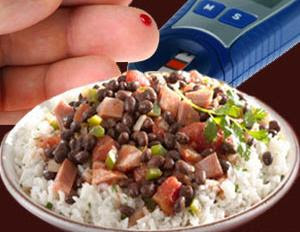What is a diabetes food list?
Being diagnosed with type 2 diabetes is a life-changing event. One of the main challenges is making changes in your diet.
One of the first questions that almost every patient diagnosed with type 2 diabetes asks is "What am I supposed to eat now?"
What you eat is a very important part of maintaining blood sugars in the target range. If a type 2 diabetic has no idea what to eat, being able to control blood sugar levels will be near impossible.
The goal in treating type 2 diabetes successfully is to make lifestyle changes.
My strategy when explaining diet is to keep it simple.
Your mindset should be one of adapting changes that enhance your lifestyle. Find something that works well for you.
There
are a lot of websites out there on the Internet touting one diet or
another. Some even speak about being able to "reverse type 2 diabetes."
Recently,
the American Diabetes Association made some changes that make it easier
for a newly diagnosed diabetic to get into action.
Do diabetes food lists really work?
In
the past there was a lot of talk about 'diabetes food lists'. Diabetes
food lists were thought of as restrictive. It's not likely that a
patient is going to follow such a diet for a long time.
The fact is that the foods on a diabetes food list will work for anyone who is committed to a healthy lifestyle.
A
diabetes food list helps people living with diabetes understand foods
that help maintain the blood sugars within the target range. They will also help to reduce hyperglycemia.
There
is a ton of information out there about what makes up a diabetes food
list. It's OK to follow these. But I recommend just using them as a
guideline that will help you to adapt healthy food choices.
Here are some of the current recommendations on how to eat healthy while living with type 2 diabetes:
Create your plate
The American Diabetes Association recently did away with the diabetes food pyramid and adapted the "create your plate."
This is a strategy that makes it less overwhelming for someone just
diagnosed with type 2 diabetes to get straight into action planning
healthy meals.
So here are the steps to create a plate:
- Take a standard sized dinner plate.
- Divide it into three sections. Start by dividing in half. Then divide one of the halves in two. There you have three sections. Since it is divided into three sections, one section will be larger.
- On the larger section of the plate, place you non-starchy vegetables such as broccoli, greens, lettuce, spinach, cucumbers, tomatoes etc.
- On one of the smaller sections, place your starchy foods like rice (preferably brown rice), grains, corn, pasta, beans etc.
- On the other small section place a serving of meat or a meat substitute such as turkey, chicken, fish etc.
- On the side you may add an 8 oz. serving of milk. Or if you are lactose intolerant like a number of adults are, you can have some almond, soy or coconut milk. Water also works just fine.
- Then a small serving of fruit. Preferably fresh fruit.
You have created your plate
Carbohydrate Counting
One
of the important strategies for a person living with type 2 diabetes is
to know the amount of sugars they are eating. This will help to reduce
the complication of hyperglycemia.
Up till the
mid 1990s, carbohydrates were touted as being bad for anyone with
diabetes. Now we know that to not entirely be the case. Naturally
everything, including carbohydrates, must be eaten in moderation.
A great tool is carbohydrate counting or "carb counting" as it is popularly called.
The
strategy is to round up the total amount of carbohydrates that you are
allowed in a day. And divide this equally among your meals - including
snacks.
One of the advantages of carbohydrate counting is that it
reduces the tendency for the blood sugar levels to fluctuate. This helps
to prevent huge swings in insulin levels that could lead to
fluctuations in blood sugar levels.
If you plan to use
carbohydrate counting exclusively, then you may need the assistance of a
nutritionist. They will help to customize a meal plan for you.
A good place to start is between 45-60 grams of carbohydrates per day.
Remember
that carbohydrates are in starchy foods like breads, grains and pasta.
They are also in fruits and vegetables, milk products.
Reading food labels makes it easier to measure how much carbohydrates you are getting in a meal.
What are Diabetes Super Foods?
The
American Diabetes Association has a list of ten super foods that it
recommends. I love the way that certain foods get tagged as "super
foods."
Just as I like to point out, these "super foods" should be a part of the diet of anyone looking to live healthy.
The
added benefit for a diabetic is that these foods help to give extra
nutrients and minerals such as calcium, magnesium, and potassium. In
addition they also contain powerful antioxidants.
These super foods help to not only control blood sugar levels. But also maintain the health of the cell membranes.
So here are the top ten super foods that everyone should be eating:
- Berries of all kinds (blueberries, strawberries, raspberries etc.)
- Dark leafy vegetables- such as spinach, kale and asparagus
- Beans- all varieties. Beans are high in fiber and low in glycemic index
- Fish particularly fish that is rich in omega 3 sources such as salmon, herring, sardines
- Fat free milk & yoghurt
- Nuts
- Tomatoes
- Sweet potatoes
- Whole grains that have not been processed
- Citrus fruits
This is by no means an exhaustive list of all the healthy ways to eat as a diabetic.
